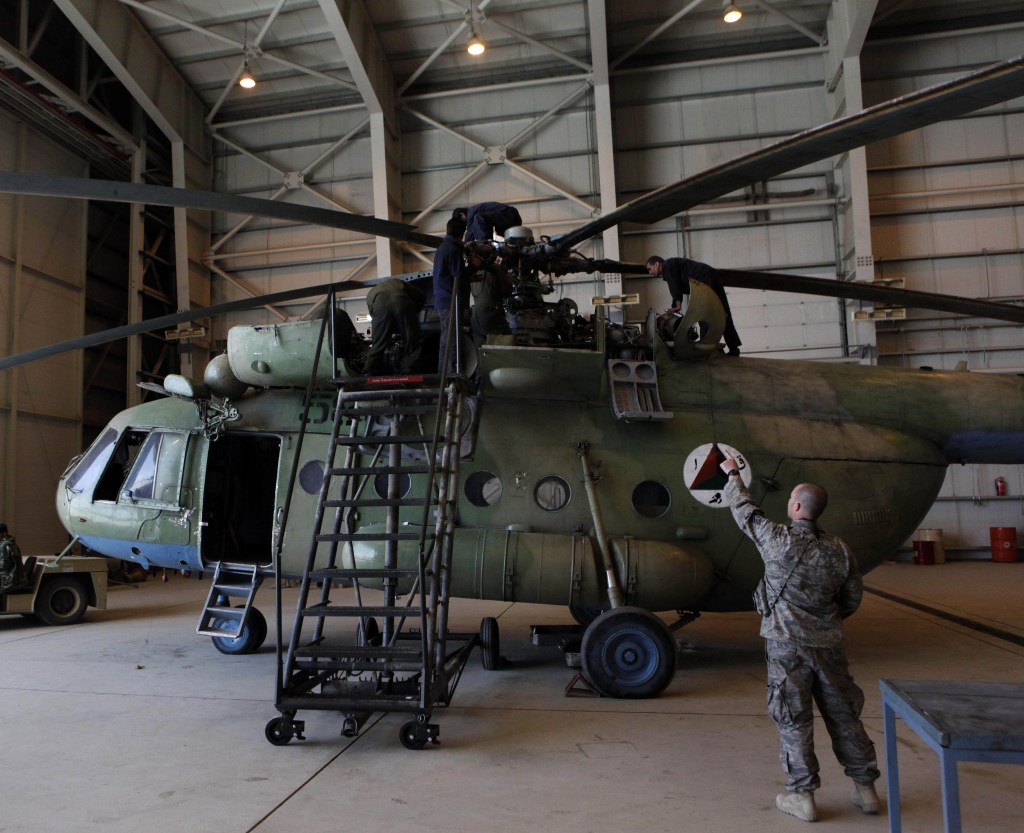WASHINGTON — The deal looked sketchy from the start.
To outfit Afghanistan’s security forces with new helicopters, the Pentagon bypassed U.S. companies and turned instead to Moscow for dozens of Russian Mi-17 rotorcraft at a cost of more than $1 billion.
Senior Pentagon officials assured skeptical members of Congress that the Department of Defense had made the right call. They repeatedly cited a top-secret 2010 study they said named the Mi-17 as the superior choice.
Turns out the study told a very different story, according to unclassified excerpts obtained by The Associated Press.
The U.S. Army’s workhorse Chinook, built by Boeing in Pennsylvania, was found to be “the most cost-effective single platform type fleet for the Afghan Air Force over a twenty year” period, according to the excerpts.
Lawmakers who were following the copter deal were stunned.
Sen. John Cornyn of Texas, the Senate’s No. 2 GOP leader and one of the most vocal critics of the contract, said the Defense Department “repeatedly and disingenuously” used the study to prove the necessity of buying Mi-17s.
WHY BUY RUSSIAN?
More than two years since the Mi-17 contract was signed, a veil of secrecy still obscures the pact despite its high-dollar value, the potential for fraud and waste, and accusations the Pentagon muffled important information.
The unprecedented arms deal also serves as a reminder to a war-weary American public that Afghanistan will remain heavily dependent on U.S. financial support even after its combat troops depart.
“So why are we buying Russian helicopters when there are American manufacturers that can meet that very same requirement?” Cornyn asked.
As recently as September, Deputy Defense Secretary Ashton Carter cited the study in a letter to House members defending the decision. Carter left his job this past week.
Last year, Frank Kendall, the Pentagon’s top acquisition official, and policy chief James Miller pointed to the study in a written response to questions posed by Cornyn.
Just a few weeks after the secret study was completed, Army Secretary John McHugh wrote in a 2011 memo “that the Mi-17 stands apart” when compared with other helicopters.
The Pentagon denies it misled Congress.
A senior department official said the study was focused on long-term requirements and not the immediate needs of the Afghan military, which were best met by the Mi-17. Also, U.S. commanders in Afghanistan wanted the Mi-17 because it is durable, easy to operate and the Afghan forces had experience flying it, according to the official, who was not authorized to be identified as the source of the information.
There’s no dispute that heavy-duty helicopters capable of quickly moving Afghan troops and supplies are essential to accomplishing that mission. But the decision to acquire them from Russia has achieved the rare feat in a deeply divided Congress of finding common ground among Republicans and Democrats.
Why, lawmakers from both political parties have demanded, is the U.S. purchasing military gear from Russia?
After all, Russia has sold advanced weapons to repressive government in Syria and Iran, sheltered NSA leaker Edward Snowden, and been criticized by the State Department for adopting laws that restrict human rights.
On top of all that, corruption is rampant in Russia’s defense industry, they say, heightening concerns that crooked government officials and contractors are lining their pockets with American money.
Overall, 63 Mi-17s are being acquired through the 2011 contract. It was awarded without competition to Russia’s arms export agency, Rosoboronexport, even though the Pentagon condemned the agency after its weapons were used by Syria to “murder Syrian civilians.”
No Pentagon official was made available to speak on the record for this story. The department declined AP’s request that it release unclassified portions of the 2010 study and other records supporting the decision to buy Mi-17s instead of Chinooks or other helicopters.
THE CHINOOK OPTION
The armed Mi-17s being purchased for Afghanistan from Rosoboronexport will replace older and less capable Mi-17s the U.S. and other countries had purchased from brokers and contractors through the open market and then donated or loaned to the Afghans.
The fact that the Afghan forces had years of experience flying the Mi-17 figured prominently in the Pentagon’s decision. Carter and other U.S. defense official contended that adding the Boeing helicopter to the mix would unnecessarily burden the Afghans with having to learn how to operate and maintain an unfamiliar helicopter.
The 2010 study outlined a transitional approach in which Chinooks being retired from the U.S. military’s fleet would be available in late 2013 to be refurbished and then replace older Russian helicopters in the Afghan fleet, according to the excerpts.
A combination of Mi-17s and renovated Chinooks, known in the Army’s nomenclature as the CH-47D, could work as well.
The study recommended a plan for converting the Afghan forces from a “pure” Mi-17 fleet to one that uses U.S. helicopters.
The Chinook option never materialized.
Send questions/comments to the editors.



Success. Please wait for the page to reload. If the page does not reload within 5 seconds, please refresh the page.
Enter your email and password to access comments.
Hi, to comment on stories you must . This profile is in addition to your subscription and website login.
Already have a commenting profile? .
Invalid username/password.
Please check your email to confirm and complete your registration.
Only subscribers are eligible to post comments. Please subscribe or login first for digital access. Here’s why.
Use the form below to reset your password. When you've submitted your account email, we will send an email with a reset code.